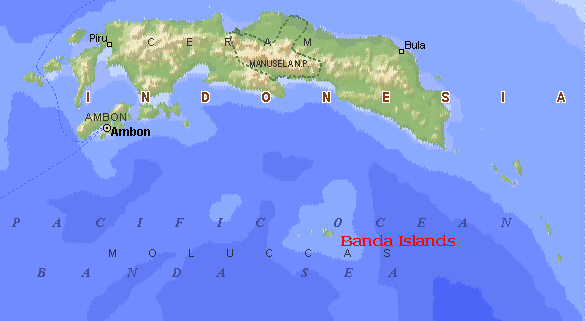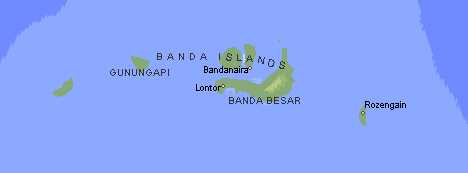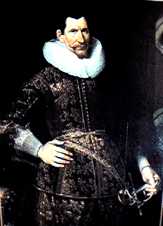 |
At the end of the sixteenth century the Dutch set out in search of the sea route around Africa to the East Indies. One of the reasons they did so was to obtain spices which were produced in the Moluccas and Banda Islands. The latter were particularly famous for its cloves and mace. When the Dutch arrived in the Bandas, situated to the south of the island of Ceram, it seemed that contacts between them and the Bandanese were to develop cordially. However, this soon changed when mutual violence occurred. In this text we are dealing with the question how Dutch-Bandanese relations developed between 1599 and 1621 and how they were influenced by the role played by competitors in the archipelago, particularly the English.
 |
The Dutch had political, strategic as well as economic reasons for opening their own direct trade route to the East Indies. The first two had to do with the Eighty Years War fought between the Dutch and the Habsburg rulers of the Netherlands which finally resulted in the official recognition of the independence of the Dutch Republic (1648). The economic reason was to share in the lucrative spice trade between the East and Europe. However, as soon as the Dutch arrived in the Indonesian archipelago they realized that competition, particularly by the Portuguese and the English, could be a threat to the profits of trade, which made them decide to establish a monopoly even if this meant having to use force (Hall p. 321). As it soon became evident that the power of the Portuguese was already in decline by the time the Dutch arrived, many of them began to perceive the English as their main competitors in the East.
When the first Dutch expedition under van Heemskerk arrived (1599), it was well received and a right to trade with the Bandas was agreed upon. However, soon attempts to establish a monopoly by forcing the islanders to trade solely with the Dutch were to meet with great disapproval by the Bandanese. As spices were in great demand, prices tended to rise making it worth while for the inhabitants of Banda to play off one competitor against the other. This soon soured relations with the demanding Dutch.
Though the Dutch presence in the Moluccas was considerably stronger than the English due to better organization, better equipment and greater financial backing (Ricklefs, p. 23), the latter were perceived as the greatest threat to the profits of the VOC. As a result of this the company tried to exclude the English from trading whenever possible even to the extend of not or very reluctantly carrying out the agreement made by England and the Dutch Republic concerning eastern trade. As the end of the so-called Twelve Year's Truce with Spain (1609-1621) was approaching and a renewal of the hostilities was likely, the States-General of the Dutch Republic thought to come to some sort of understanding with the English. The agreement, concluded in 1619, contained provisions for sharing the spice monopoly. A third of the trade was for the English, two thirds for the Dutch. Long before the agreement there had been incidents between Dutch and English traders in the archipelago and the treaty, news of which only reached the Indies in April of the following year, largely remained a dead letter, mainly due to open obstruction of it by Jan Pieterszoon Coen, governor-general of the VOC from 1617-1623 and again from 1627-1629. Coen was determined to do whatever lay in his power to enforce the Dutch monopoly even to the extend of using force.
Problems in the Bandas started when in 1602 five Dutch traders on the islands, part of a group that had stayed behind in expectation of the next trading fleet, were murdered while the remaining ten were forced to leave. Apparently a quarrel about a Dutch loan to the Bandanese lay at the bottom of this incident (Van Goor, p. 85). Despite this the 1602 trade agreement was renewed in 1605, but again the Bandanese continued their trade with the English and other competitors of the VOC.
 |
In 1609 a large Dutch fleet under admiral Verhoeff arrived in the Bandas. Though reluctantly the inhabitants of Banda Neira offered Verhoeff the right to build a fortress and they somehow managed to convince the admiral and his company to come ashore without bringing a guard. He was ambushed and murdered together with forty-six others. The fortress however was established by his successor vice-admiral Hoen and a new trade agreement signed, which was again from time to time ignored by the Bandanese. Though the Dutch managed to strengthen their position in the Bandas and the Moluccas, incidents with the English who persisted in their efforts to trade continued. These efforts, though greatly irritating the Dutch, had only limited success, mainly because the English were not powerful enough to offer the natives sufficient support in the event of Dutch retaliation (Hall, p. 325). The VOC on the other hand showed a growing determination to have its own way.
 In 1613 the Englishman John Jourdain founded a factory at Macassar. Soon he became the leading figure in the struggle against the Dutch, particularly when he became president of the English settlement at Bantam on Java. Jourdain thought a show of determination would constrain the Dutch, but he underestimated Jan Pieterszoon Coen. When the English seized a Dutch ship, the Zwarte Leeuw, off Bantam in December 1618, to use as a security against VOC actions, Coen attacked the English factory at Jacatra and destroyed it. Leaving a garrison to defend the VOC position at Jacatra he sailed to the Moluccas for reinforcements and returned in May to relieve the Dutch and drive the English and the forces of the sultan of Bantam out. Jacatra rose out of the ashes to which it was reduced by Coen as Batavia, which would become the administrative centre of the VOC and later on the capital of the Dutch East Indies until 1949.
In 1613 the Englishman John Jourdain founded a factory at Macassar. Soon he became the leading figure in the struggle against the Dutch, particularly when he became president of the English settlement at Bantam on Java. Jourdain thought a show of determination would constrain the Dutch, but he underestimated Jan Pieterszoon Coen. When the English seized a Dutch ship, the Zwarte Leeuw, off Bantam in December 1618, to use as a security against VOC actions, Coen attacked the English factory at Jacatra and destroyed it. Leaving a garrison to defend the VOC position at Jacatra he sailed to the Moluccas for reinforcements and returned in May to relieve the Dutch and drive the English and the forces of the sultan of Bantam out. Jacatra rose out of the ashes to which it was reduced by Coen as Batavia, which would become the administrative centre of the VOC and later on the capital of the Dutch East Indies until 1949.
When the English under George Ball arrived at Banda Neira in March 1615, they were met by a strong Dutch force. Ball therefore decided to divert his ships to Ay in order to get cargo. The Dutch however attacked the island, but were driven off by the natives with English help. This was only a temporary success. The Dutch were by now determined to establish their monopoly by force (Hall, p. 326). Even though the English sent a small fleet to the Bandas again in 1616, which could not do much to assist the natives in the face of overwhelming Dutch power, the latter overran Ay in December. The English thereupon sent two ships to the isle of Rhun offering it protection, but they were seized by the Dutch. VOC admiral and predecessor of Coen as governor-general, Laurens Reaal offered the English a deal: if they agreed to allow the Dutch to treat the islands as they saw fit, their ships would be returned. The English refused. However brave this refusal looked, it did not help the natives much, as the English could do little more than offering encouragement. In November 1617 Reaal demanded the English evacuation of Rhun. The English refused to do so and for the time being the situation remained as it was, though through English instigation there were several attacks by locals on the Dutch on Banda Neira (Fort Nassau) throughout 1618 and 1619. After the destruction of Jacatra Coen decided it was time to strike in the Bandas. The final act of the drama however was delayed by the arrival in the archipelago in April 1620 of the news of the Anglo-Dutch treaty, news that must have certainly displeased the governor-general.
In the nineteenth century Jan Pietersz. Coen became one of the popular great men in Dutch history and he remained so until well into the twentieth century . Few Dutch historians however would now agree with the words of admiration once used to describe the establishment of VOC power in the archipelago: 'Daar werd iets groots verricht' (Something great was achieved out there). No doubt Coen did establish the VOC monopoly in the Bandas and generally put Dutch power in the archipelago on a strong footing, but the way he did so was even in his own days not wholly uncriticized.
Though officially the English were to have their third share in the spice trade of the Moluccas and the Bandas, Coen took his time to act according to the Anglo-Dutch treaty, to such an extend that some historians accuse him of openly sabotaging it (Hall, p. 331). The treaty implied that the instructions Coen received from Holland in 1618 to use force if necessary to expel all foreigners from the archipelago did not apply to the English. However, Coen decided that this should but remain a dead letter. He insisted on the need to occupy the islands as the only way of establishing the VOC monopoly.
Using the pretext that the Bandas traded with the Spanish enemy on Tidore, a VOC squadron under Coen attacked Lonthor (Banda Besar) in January 1621. Though the islanders resisted fiercely they were forced to surrender in March. Fearing a Dutch attack the inhabitants of Rhun made their submission too. The Bandanese were convinced that they were betrayed by the English who did not offer any help because they lacked the power to do so and also felt bound to the Anglo-Dutch treaty (Haal, p. 332). Soon after their official surrender the people of Lonthor (Banda Besar) started a serious revolt. This came to Coen as a present from heaven, because it gave him the excuse to carry out his plan to solve the problem of the Bandas once and for all. This meant removing all the original inhabitants from the islands and repopulating them with settlers from elsewhere that would be fully loyal to the VOC. This plan was ruthlessly carried out after first having treated and executed the headmen accused of leading the revolt. Even in Coen's own days servants of the VOC who were witnesses on the scene were shocked and disgusted by the violence used (Van Goor, p. 82/ Hall, p. 333).
The conquest of the Bandas and the subsequent clearances of the islands meant that the Anglo-Dutch cooperation as provided for in the treaty of 1618 had completely broken down even though in name it still existed. The final blow came on the island of Amboina (Ambon) in 1623, when eighteen English traders were arrested by the Dutch. They were accused of conspiring against the Dutch fortress and thereupon tried and executed.
Violence was not an uncommon way for powerful traders in the archipelago to set things right in case they felt wronged. In many ports violence was not, or not yet, a monopoly of the state. The situation varied from place to place, but particularly in those areas where states were either small and weak or not yet fully developed, trading companies like the VOC and the EIC tended to fend for themselves. Already the first voyage of the Dutch (1595-97), under the rude and strong-headed Cornelis de Houtman, was marked by violence (Van Goor, p. 82/83). It was not constricted to the Europeans either, although their influence and power, both financial as well as military, played an important role in the continuously flaring up of conflicts between the myriad of competing smaller and bigger states in the archipelago.
When it was founded the VOC was not only granted a trade monopoly with the East by the States General of the Dutch Republic, but it specifically obtained the right to maintain men of war as well as to raise an army not only in order to establish and defend its monopoly, but also to wage war on the enemies of the Republic, the Spanish and Portuguese. Once in the east the Dutch soon began to see the English, who followed in their trail, as the largest threat to their monopoly. At first this quite surprised the English, who sympathized with the Dutch in their struggle against the king of Spain and who tended to see them as their natural allies in Europe (Hall, p. 321). As Hall implies, the English no doubt reacted indignantly towards the aggression by the Dutch, which probably made them more determined to get their share of trade without giving in to demands they thought profoundly unreasonable. This reaction however may have been regarded by the Dutch as proof of the soundness of their suspicions against the English and therefore encouraged them to drive the enemy out, if needed by force.
No doubt the violence used by Coen was excessive and recognized as such at the time. Yet Coen was never condemned nor reproved by the Heeren XVII (the board of governors of the VOC). Dutch violence was probably encouraged by three factors. First of all irritation about English insistence on trading with the Bandas and fear that this would finally lead to a failure in maintaining the VOC's valuable trade monopoly and secondly the behaviour of the Bandanese themselves who were constantly breaking their agreements with the Dutch not seldom using violence and murder as well, as we saw in the case of admiral Verhoeff and his company. Thirdly the person of Coen himself, a headstrong man who was to carry out his mission with whatever means possible in the most determined way. A man with only one thing in mind: the interests of the VOC.
At first it looked like relations between the Dutch and the Bandanese would develop peacefully, but they were soon at loggerheads with each other. The Dutch insisted on establishing a trade monopoly, but the Bandanese thought to profit from the continuously rising price of cloves and mace and therefore carried on their trade with the competitors of the VOC, particularly the English. The Dutch, who became more and more suspicious of the English and who feared the monopoly would finally be lost, decided that the only way of maintaining it was to conquer the islands. The actual conquest was only slightly delayed by the Anglo-Dutch treaty, which was almost certainly willfully ignored by Jan Pietersz. Coen. That he could do so shows how powerful the VOC had become as a 'state in the state.' Even though there was some criticism of the excessive violence Coen used in the Bandas, his actions were finally approved by his superiors and the States-General and until far into the twentieth century looked upon as a token of Dutch enterprise and heroism in the east.
Literature J.H.C. Blom & E. Lamberts (ed.), Geschiedenis van de Nederlanden. Amsterdam 1994. C.R. Boxer, The Dutch Seaborne Empire. Harmondsworth 1973 (1965). D.W. Davies, A Primer of Dutch Seventeenth Century Overseas Trade. The Hague 1961. Holden Furber, Rival Empires of Trade in the Orient, 1600-1800. Minneapolis 1976. Femme S. Gaastra, De Geschiedenis van de VOC. Zutphen 19912 . J. van Goor, De Nederlandse KoloniŽn. Geschiedenis van de Nederlandse expansie, 1600-1975. The Hague 1994. D.G.E. Hall, A History of South-East Asia. 4th Edition. London 1981. Jonathan Israel, Dutch Primacy in World Trade, 1585-1740. Oxford 1989. M.C. Ricklefs, A History of Modern Indonesia. London 1988. Jan & Annie Romein, Erflaters van onze beschaving. Nederlandse gestalten uit zes eeuwen. Amsterdam 19719 (On J.P. Coen).